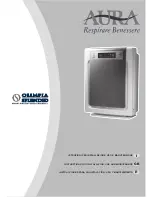
17
• Considering the wall structure, the outdoor unit should be installed on a flat surface to avoid raspy noise, echo and vibration.
• Choose a place that will not take direct sunlight. If the selected place is exposed to direct sunlight, the outdoor unit should be
shaded.
• Install the unit at the site where it is exposed to as little wind as possible, especially in areas where it is frequently windy.
• If the installation site is exposed to heavy winds, such as in coastal areas, place the unit along the widest part of the wall or use
protective plates.
• Select a dust-free location where the air flow is good, which will not obstruct the air inlet and outlet of the appliance.
•
Choose a place that can be easily assembled. It should be ensured that the selected location is a place where the possible
service intervention can be made easily.
It is strictly forbidden to place the outdoor units on the ground. If it needs to be placed on the ground, mounting
must be done on the console of the outdoor unit by installing the console to the nearest distance of the ground. If this
situation is not possible, mounting must be done above the rubber wedges with screw
.
5.4
Installation Summary
You can see the summary of installation below. For other details and installation visuals, please refer to the supplied installation
manual.
5.4.1
Indoor Unit Installation
Installation the Wall Mounting Bracket
•
The mounting plate of the indoor unit is removed from the product
•
The location of the installation is determined. The distance of the product from the ceiling should be adjusted to a minimum of 15
cm. Install the wall mounting bracket horizontally over the structural parts on the wall using the spaces indicated on the bracket.
Balancing must be done with water level gauge during the process.
Drilling the Hole
• While the holes required for mounting the mounting plate is marked, the indoor unit wall plate is used as a template.
•
The location of the holes which the connection pipes and the drain hose will located is determined.
Connective Pipes
• Cut out the marked area from the right side or left side of the rear body with a saw, etc. Smooth the cut edges.
•
The indoor unit connection pipe should be moved slowly and manually supported from the corner in order to avoid damage to
the pipe when opening and bending. Pipe bending is very critical, especially when the pipe outlet is from the right side.
• Improper bending operation of the pipes may cause cracking, rupture, constriction or excessive noise of refrigerant flow.
Drainage
• If the product have double drainage pipes outlet ( for 18K BTU/h products), give the mounting plate some inclination (1 - 2
degrees) in which direction the water discharge hose will come out.
•
The outlet direction and the slope of the drain hose must be taken into account while opening a hole through which the pipes will
pass.
• If there is only one drainage pipes outlet direction in the drain pan, there is no need to tilt this outlet. Because there is the required
slope inside the pan.
Fastening the Indoor Unit
•
Pass the piping through the hole in the wall.
• Put the upper claw at the back of the indoor unit on the upper hook of the wall mounting bracket, move the indoor unit from side
to side to see that it is securely hooked.
• Push the lower part of the indoor unit up on the wall, then move the indoor unit from side to side, up and down to check if it is
hooked securely.
Piping and Wrapping
• Bundle the tubing, connecting cable, and drain hose with tape securely and evenly as shown in the side ward figure.
• Because the condensed water from rear of the indoor unit is gathered in ponding box and is piped out of room, do not put
anything else in the box.
5.5
Outdoor Unit Installation
• During heating operation, the condensate and defrosting water should be drained out reliably through the drain hose.
• In case of a drain hose, the unit must be installed on a base more than 5 cm height.
Summary of Contents for ZS12V70CCHI
Page 1: ...EN Service Manual Split Type Air Conditioner ...
Page 61: ...EN ...
















































